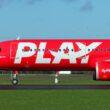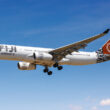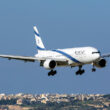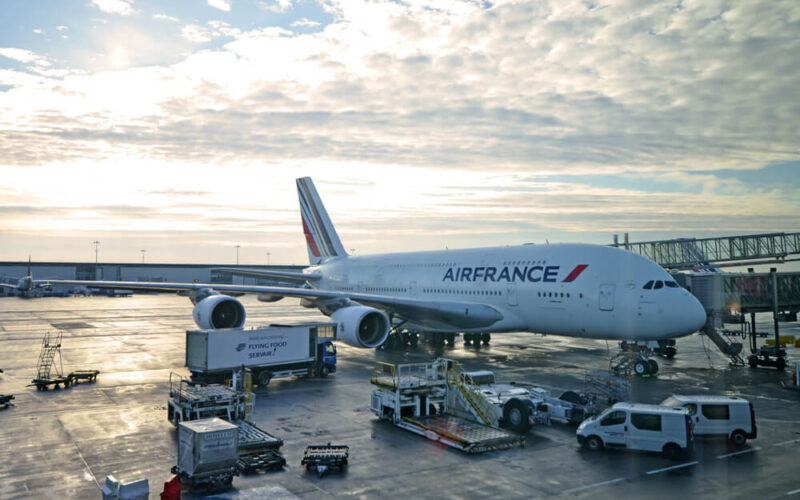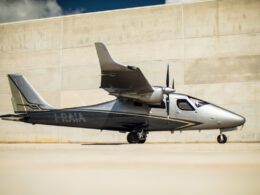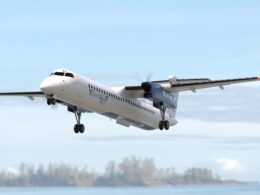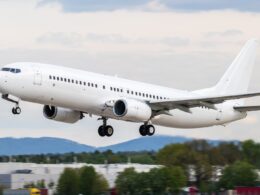On September 30, 2017, Air France’s Airbus A380 (registered F-HPJE) started out its day as per usual, operating Flight AF66 from Paris-Charles De Gaulle International Airport (CDG) to Los Angeles International Airport (LAX) with 497 passengers and 24 crew members onboard. What commenced after the aircraft took off, however, was far off normal.
While cruising over Greenland, the number four engine suffered a failure. Its fan, the first rotating assembly at the front of the engine, together with the air inlet and fan case, separated during the flight. The Airbus A380 landed safely at Goose Bay, Canada (YYR) with no injuries to the people on board.
The investigation is still under progress and no final report is yet published. The Bureau d’Enquêtes et d’Analyses pour la sécurité de l’aviation civile (BEA), the designated investigator of the incident, published an update on the challenges and difficulties of locating the engine parts, which was finally achieved in June 2019 after a 21-month long search campaign.
ARTICLE: Engine part of Air France A380 found under Greenland ice
Three-phase operation
The search for the engine parts was split into three phases:
Phase I, a 12-day visual scan of parts laying on the ice sheet;
Phase II, where an aerial campaign using synthetic aperture radars (SAR) tried to detect parts under the ice sheet was combined with a ground campaign, which utilized ground-penetrating radars (GPR) after SAR identified potential locations of the parts, however, Phase II ended without any conclusive results;
Finally, after the completion of Phase II at the end of 2018, with new targets identified by ONERA, a French aerospace research center, and the availability of a new electromagnetic sensor, BEA made the decision to conduct Phase III in May 2019. However, difficult weather conditions postponed the search to June 2019, which finally resulted in the recovery of engine fan hub fragments that still had its fan blades attached to it on June 30, 2019.
Narrowing the territory down
The first challenge was to narrow down the potential area where fragments of the Engine Alliance GP7000 could have fallen. BEA notes that a simulation was used to “estimate the size, mass, velocity and angle of ejection of each hub fragment, to help refine the ballistic computation and the search area on the Greenlandic ice sheet.” Engine Alliance used the LS-Dyna fan hub failure simulation.
The area was further narrowed down by defining the position of the Air France A380 during the failure. French investigators, coupled with Airbus, decided to use the position indicated by the Flight Management System (FMS), a combination of GPS and Inertial Reference System (IRS) data. The next step was to determine the altitude and pursue ballistic calculations. Calculations were done by the BEA, the National Transportation Safety Board (NTSB) and Airbus. Further analysis of radar data imagery was done “in order to reliably detect the fragments being searched,” noted BEA’s report.
Ground-penetrating radars (GPR) were concluded as a “sub-optimal instrument choice for a wide area search,” thus the investigators decided to explore several newly available options if a new search operation was to be launched.
“[…] more effective detection sensors with a bigger swath and giving a more robust response were needed to launch Phase III.”
RECCO systems, an “off-the-shelf, mature device which is used for avalanche search and rescue procedures,” sniffer dogs and electromagnetic (EM) sensors were considered for Phase III. In the end, electro-magnetic sensors prevailed. However, they had to be adapted to a system called the SnowTEM, as the “depth at which the missing part was located and its characteristics could not be worked on,” with traditional and available EM sensors.
Only then BEA deemed that it was “acceptable to launch a new search campaign in Greenland in the spring of 2019,” as there was a belief that “SnowTEM would detect the missing part up to a distance of five to six meters.” The investigators calculated that the parts were buried under four meters of snow, thus there was a high possibility of finding the engine fragments to finalize the report of the incident of Flight AF66.
Three target locations
Thus, a base camp was set up in Narsarsuaq, Greenland. 6,400 kilograms (14109 lbs) of equipment were required for the operation, including a container that was shipped from Copenhagen, Denmark: some 1,800 miles (2,932 kilometers) away.
Three target locations were identified: target 1, target 2a and target 2b. On May 20, the team on the ground concluded that the possibility of engine parts being there was “highly unlikely.” The same results were concluded for target 2b on May 23, 2019.
The same day that target 2b was ruled out, target 1 provided a “clear and unambiguous signal” within five minutes after the start of the search using SnowTEM. But the extraction of the parts had to be postponed, due to the fact that the right gear was not available at the time and team members had other commitments. The decision was made to dig out the parts at the end of June 2019.
The first meter of snow was dug out by hand and chainsaws. The second and third and a half meter would be removed the same way, except a ramp would be used to remove the excess snow and ice. The final few centimeters would be melted using a heater. In the morning hours of June 28, 2019, the digging began and after six hours of manual labor, a “shovel came twice into contact with a metallic part.” To prevent any damage to the blades, the heater was turned on.
“It was confirmed at that time that this part was a fragment of the hub with blades attached.”
The part, after a three degree-of-freedom hoist was built by hand, was placed on a shed and reached the surface via the ramp.
“Finding this fragment was key for determining the root cause of the engine failure. An Annex 13 safety investigation report will be made available to the public on the BEA website in mid-2020.”
Accident @Airbus #A380 registered F-HPJE and operated by @airfrance on 30/09/2017 en route over Greenland / uncontained damage on engine while cruising, diversion / Publication ot the technical report n°2: Phase III field campaign and part extraction. https://t.co/FANVsKgfOF pic.twitter.com/2j0oUcDU9o
— BEA (@BEA_Aero) June 4, 2020

